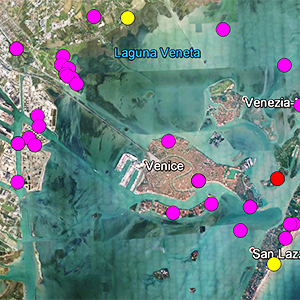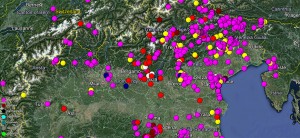Injections may be better for large trees with a regular shape, while topical applications may be better for large, irregular, gnarly trees.
In order to obtain maximum efficacy with oak phosphonate treatments, minimum temperatures should not be below 50 ºF. Maximum daytime temperatures should be higher than 60 ºF, but not exceed 85 ºF.
Based on the study published by the UC Berkeley Garbelotto lab in California Agriculture (http://nature.berkeley.edu/garbelotto/downloads/calag2009.pdf), azomite and/or lime washes alone are not effective in controlling SOD.
While phosphonate injections to help control SOD are now recommended once every 2 years, spray applications should still be applied to the bark of oak trees annually.
Once bark beetles attack the main stem (trunk) of an oak, the tree is on its way out. Insecticide treatments will not save it. Oak beetles are attracted to trees that are severely compromised. They cannot attack healthy trees.
The correct approach to avoid bark beetle infestations is not to apply insecticides, but rather to identify any health issues a tree may have. As of October 2015, many trees are suffering from the prolonged drought and may need watering. Watering should be applied infrequently and never during the summer. Water-starved trees may display a thinner crown, with olive-green rather than dark-green leaves. Leaves may also be crisp when folded between your fingers. If you opt to provide water to an oak tree that is severely water deprived, make sure the water reaches a depth of about one foot below the soil surface. Also make sure the flow is low to avoid flooding the base of the tree.
If SOD phosphite treatments are being applied by injection November 1st – December 15th, data has shown that treating every 2 years is sufficient. When preparing the injections, be sure to use the most current dosage recommendations as they have recently been updated. Current recommendations can be found at http://nature.berkeley.edu/garbelottowp/?page_id=2345. The new dosages are significantly more diluted than the original label dosages, yet are just as effective and cause almost no damage to the wood (the original label dosages do cause some wood damage).
If SOD phosphite treatments are being applied using a topical bark application, treat every 1 – 2 years. While data has shown that topical applications last for 18 months, fall treatments are the most effective. Therefore, in a county known to be infested, treat trees in riparian areas, within 20 miles of the coast, or within 2 miles of redwood forests every year. Treat trees in drier areas (of infested counties) every 2 years.
Phosphonate is only intended to be used on trees that do NOT have sudden oak death (SOD). Once a tree is infected, it is of no use. It helps to boost the tree’s own immunity system against the pathogen. So, if a tree is very susceptible to P. ramorum (the pathogen that causes SOD), then it may still get infected and die, even with the phosphonate treatment. Really, the phosphonate just helps increase the odds that a moderately susceptible tree will be able to ward off infection. So, it is an odds game and you are just increasing your odds of success. Variables that contribute to success include tree susceptibility, disease pressure in the area, hosts present in the area, and environmental conditions.
Research has identified coast live oak individuals that may be somewhat resistant to SOD, possibly because of the presence of some chemicals in the bark and phloem. However, there is no information yet on how genetics and the environment may affect this trait.
Tanoak has some mother trees that produce SOD-tolerant seedlings and some that produce seedlings that respond very well to phosphonate treatments. These tanoak families are at UC Berkeley, but are not currently commercially available.
Yes, you can apply phosphonate to your oak trees to help protect them from sudden oak death. You can find it in many Bay Area garden supply stores.
If you apply it topically to the bark, you will also need the surfactant Pentra-Bark® and you will need a sprayer. If you choose to inject it, you will need enough injectors to treat your largest tree (1 injector every 6 inches around the circumference). Treatments should be applied between November 1st and December 15th for best results.
For details on how to apply phosphonates, go to www.matteolab.org, “Treatment and Diagnosis” (at top of page).
The symptoms on your oak may be caused by a range of issues. If oozing is accompanied by the presence of fine sawdust, then the tree is dying. Even if it is still green you may want to consider removing it if its failure may cause harm to people or property. The fine sawdust is caused by beetles tunneling in the tree. Oaks are only attacked by beetles when dying. If no sawdust is present, then the tree’s condition may be reversible.
Unfortunately, it is difficult to determine what may be the cause of the symptoms you describe. Sudden Oak Death (SOD) can attack an oak tree if California bay laurel is within 60 feet of the oak. You can use the free SODmap Mobile App to determine if you are in a high or moderate risk zone for SOD. To find out how to do that, go to www.sodmapmobile.org. There is also a YouTube video you can watch at https://youtu.be/zE0_q3EmIfs. If the information you gather suggests that it may be SOD, then repeat the phosphite bark application (such as Agri-Fos® combined with Pentra-Bark®) in the fall between October 30th and December 15th. You may also want to consider removal of bays within 30 feet from the oak. Go to http://nature.berkeley.edu/garbelottowp/?page_id=909 to find out about upcoming treatment training sessions to learn more about treatment options. If there are no bays within 60 feet of your oak and the SODmap mobile risk is low, then it likely isn’t SOD.
If you have watered your oak, it may be a root disease such as the oak root fungus or Phytophthora cinnamomi root disease. Make sure you stop watering and expose the upper root system to the air to slow disease progression. If you have never watered your oak, then it may be a secondary disease brought on by the long drought (ex. oak die-back fungus). These are diseases that are strongly affected by the genetics of the tree and weather conditions. In this case, you may want to try watering the tree now and then once again in 2 weeks. Then water once a month starting October 15th. Do not water between July 10th and October 15th. Watering should be done using a low flow approach to ensure that the soil gets wet up to 1 foot down and that no flooding of the tree ever occurs. Unfortunately, if the secondary disease is too advanced, despite all efforts, the tree may still die.









